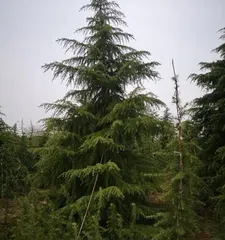Cedar is a very beautiful tree species, loved by people for its graceful appearance and excellent economic value. However, to ensure cedars grow healthily and achieve the desired results, proper care is required. This article will detail how to care for cedars.

Choose the right soil
Cedar roots are well-developed and require deep, well-drained, fertile, and organic-rich soil. To achieve this, we can use suitable soil for cedar cultivation. We can add an appropriate amount of sand, leaf mold, and garden soil to the purchased soil to obtain the best soil quality.
Watering appropriately
Cedars need to maintain moderate moisture, but avoid overwatering. Overwatering can lead to root suffocation, wilting, or other problems. When watering, pay attention to the soil's dryness and water as needed.

Pay attention to sunlight exposure
Cedars need plenty of sunlight, but also need to avoid excessive exposure. In the hot summer, tools like shade nets can be used to block sunlight and maintain suitable temperature and humidity.
Pruning in a timely manner
During the growth of cedar, if there are conditions like withering, wilting, or pests and diseases, they need to be pruned in time. At the same time, pruning can also be used to shape the cedar to make it more beautiful.
Fertilization precautions
The growth of cedar requires sufficient nutrients, so fertilization is also crucial. We can choose organic or chemical fertilizers and apply them in appropriate amounts in spring and autumn.

Suitable temperature range
Cedars prefer a mild climate, with a suitable growth temperature of 18°C-22°C. In the hot summer and cold winter seasons, it is necessary to maintain a suitable indoor temperature.
Avoid wind damage
Because cedar trees are tall, they are easily blown down by the wind, so it is important to avoid wind damage during cultivation. You can choose appropriate windbreak nets or other protective measures to reduce the risk of wind damage.
Pest and disease control
Cedars are also susceptible to pests and diseases, such as loopers, powdery mildew, and pine caterpillars, and timely corresponding control measures need to be taken.
Pay attention to ventilation
Cedar growth requires a well-ventilated environment, so it is important to open windows for ventilation in a timely manner during cultivation. At the same time, avoid indoor temperatures that are too low or too high, which can affect cedar growth.
Appropriate irrigation
In the hot summer and dry seasons, cedars need appropriate irrigation to maintain moisture and avoid drought. However, during the rainy season, the amount of watering needs to be reduced.
Clear fallen leaves
The fallen leaves of cedars also need to be cleared in time to prevent accumulation and bacterial growth. Weeds and dry branches can also be cleared.
Pay attention to water quality
When watering, pay attention to the water quality, and avoid using water sources with high salt and fluoride content. These substances can adversely affect the growth of cedars.
Master the suitable cultivation time
Choosing the right time for cultivation is also very crucial. In spring or autumn, the mild temperature and suitable light and humidity conditions can promote cedar growth, while in summer and winter, attention needs to be paid to maintaining suitable indoor temperature and humidity.
Regularly check the cedar
Regularly checking the growth status of the cedar is very important, as it allows for timely discovery and resolution of problems. We can observe parts of the cedar such as its leaves, branches, and roots to determine if they are healthy.
Caring for cedars is not an easy task; it requires care, patience, and skill. Only by mastering the care techniques can cedars grow strong and healthy, allowing you to enjoy the beautiful scenery.